Removing the 'isolation' from student quarantine housing
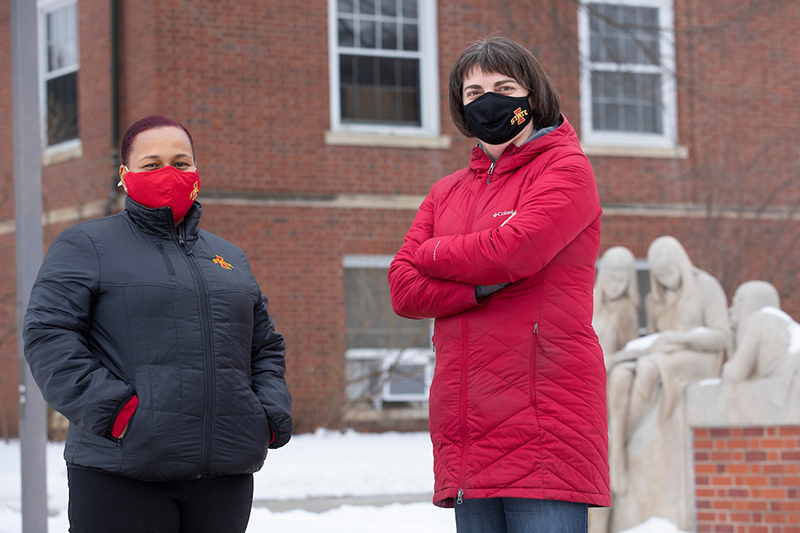
Residence Life director Virginia Speight (left) and associate director Susan Lammers served as live-in advisors to students assigned to isolation or quarantine housing during fall semester. Photo by Christoper Gannon.
As she readied for an extended student move in and mandatory COVID-19 testing last July, residence life director Virginia Speight had her own move to complete. An Ames home renter the last four years, she let her lease expire, stored much of its content and moved with her Rottweiler, Jeanny, into the two-bedroom hall director's apartment in Oak-Elm residence hall, the designated quarantine residence for Iowa State students exposed to COVID-19. Across the Richardson Court quadrangle, Linden Hall housed students isolated after a positive test for the virus.
Speight and one of her associate directors, Susan Lammers, opted to serve as live-in advisors to the students temporarily assigned to one of the buildings. If they couldn't find the fix themselves, they knew who on campus could. They envisioned it as an after-five and weekends emergency assignment, with the two professionals tag-teaming on a weekly cycle. Lammers moved into the Linden Hall director's apartment when it was her week.
Speight said three factors steered their decision:
- To protect all students, Iowa State would provide isolation and quarantine residences -- and staff them 24/7.
- So early in the pandemic, there were no best practices to draw from.
- She wouldn't place the department's hall directors or community advisors in the assignment.
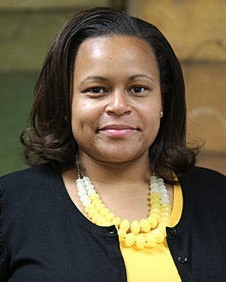
Virginia Speight
"That's not what they signed up for," Speight said. "We talked briefly about contracting it out, but my brain kept asking, 'Virginia, is this something you could do -- provide a direct connect to the residence life piece -- given where you are personally and professionally?'
"I knew I couldn't do it alone," she continued. "With the commitment Susan has to the institution, our students, the department -- and her history here living on campus -- I knew she was a partner I could count on. So I asked."
Lammers, who served as resident advisor in Oak-Elm as a Cyclone undergraduate and last worked as an ISU hall director in 2006, ran through the same self-assessment.
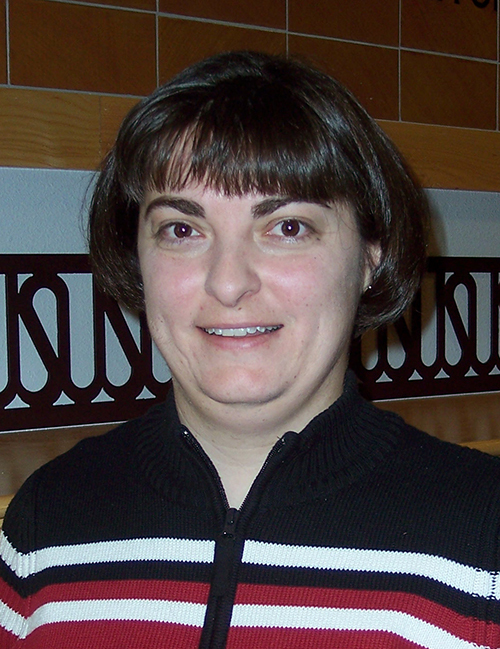
Susan Lammers
"It came down to: Somebody has to do it, we have to serve these students," she said. "The word 'isolation' is so counter to what we believe in, in residence life. We're about community and helping people build connections. I kind of had to rewire my brain in the beginning, reframe how to help them feel connected."
The answer, Lammers said, was to answer every email, every phone call, no matter how big or small the question.
"Thank goodness Virginia and I had each other, because it was some of the most stressful work I've done in residence life," she said.
Busy start
In fact, it would be mid-September before the gig settled into a nights and weekends job. With COVID-19 testing required for campus move in, and with more than 400 students getting tested daily Aug. 3-16, they knew August would challenge them -- and it did. During the peak weeks, about 130 students were assigned to isolation or quarantine (I/Q) campus housing. The work often was double that because in addition to serving their students, Speight and Lammers were serving parents, too. It was a time of nearly constant phone conversations.
"Parents on the phone had one piece of information: My child has to move into quarantine housing," Lammers said. "They didn't know where to start, and we had to be dialed into that need, too, for weeks.
"I don't know how many times I said 'I'm not a doctor' or 'I'm not a public health official.' But that didn't mean I didn't need to reassure them that their student was safe and being cared for."
Team effort
When residence students tested positive for COVID-19, Speight or Lammers received that information from the Thielen Student Health Center. They contacted each student to see who was moving home and who would stay on campus. Then they assigned rooms in Oak-Elm or Linden to those staying, updated ISU Dining about meal delivery and alerted a team contracted from Nationwide to clean rooms, move students' belongings into them and deliver meals to their doors. Speight said students could bring as much as they wanted to their temporary room: TV, video game console, Netflix account, etc.
Once students arrived, Speight or Lammers went to work, answering emails and phone calls and running errands: find a forgotten pillow back in their room, pick up a thermometer at Thielen Student Health Center, buy a box of tissues, retrieve a video game, pick up mail at their residence hall, whatever it took.
Other residence life staff assisted during the work day -- Speight and Lammers still were trying to lead their residence life team, too -- but after five, it fell to the one on duty.
"With every interaction, they needed to know we cared. They had to know that if they had a question at 2 a.m., that phone was going to be answered," Speight said. "You have to 'hug' them through every interaction you have with them on the phone. Or when you bring something to their door, not have a look on your face that says 'I know you have COVID.'"
Both leaders said they observed the change in students, from being angry or scared initially about their COVID exposure, to being grateful for the services they received.
"After 24 hours, they understood we were going to help them be successful in that space," Speight said.
Double duty
Noteworthy effort
For her marathon service, Virginia Speight received a COVID-19 Exceptional Effort Award in student support "for managing the logistics for students needing quarantine and isolation spaces, comforting nervous students and responding to anxious parents."
About the time student numbers in isolation or quarantine started to ease a bit in mid-September, Lammers' family suffered a medical emergency. While she continued to do her first job, she no longer was able to share night/weekend duty with Speight on Richardson Court. So, Speight committed to finishing the semester herself, and the department brought in a temporary employee to help during the day with the administrative tasks of I/Q housing.
"It was for the students, but it also was for my staff," she said. "COVID is so stressful for my staff. The point of our work is to be attached, connected and engaged, so to have to stand down and step back is really hard for all of us."
Speight estimates she assisted 30-40 students at a time through October and then the numbers finally dropped off. For a couple weeks at semester break, the halls were empty. When students returned to Ames for winter session or jobs, one or two typically lived in I/Q housing.
The plan this spring? Speight will remain in her Oak-Elm apartment and continue to cover nights and weekends.
"We have very good administrative help during the day, and we have all our campus partners who back us up. Certainly, this is not something we could do, or did do, alone," Speight said. "We hope our numbers stay low, but with fall semester behind us, I do feel better about what to expect for spring. We'll make it work."
Related stories
Wintersteen talks appropriations, COVID challenges, tenure with legislators
President Wendy Wintersteen emphasized Iowa State's role in preparing a well-trained workforce and growing Iowa's economy during her annual funding request to the Legislature's joint education appropriations subcommittee Feb. 3.
She cited many examples that define an Iowa State education and make Iowa State graduates especially useful to the state and its employers:
- No. 11 national ranking among more than 300 public and private universities for undergraduate entrepreneurship programs, according to the latest ranking by the Princeton Review.
- The “Innovate at Iowa State” brand represents the university's growing national leadership in preparing the next generation of innovators and entrepreneurs and is a key differentiator. "No other university is doing student innovation on this scale," she said.
- More than half of ISU students are enrolled in a STEM field.
- Students have hands-on, experiential and leadership opportunities outside the classroom through activities like undergraduate research, 900 student clubs and organizations, and 90 learning communities.
"The comprehensive ISU experience -- both in and outside the classroom -- ensures that ISU graduates are workforce-ready," Wintersteen said.
She noted that ISU students are graduating more quickly than ever, with the average time to complete a bachelor's degree now down to 4.4 years.
The request
Iowa State's funding request to the Legislature for the fiscal year that begins July 1 remains unchanged from what the state Board of Regents sent to the state in October:
- Restore the $3.2 million state reduction to the current operating budget.
- Increase the general education appropriation $7 million.
- Increase economic development funding $2.175 to support three platforms (biobased chemicals, precision and digital agriculture, and vaccines and immunotherapy) assigned to Iowa State to spur commercialization efforts and support the state’s bioeconomy. The University of Iowa is pursuing a medical devices initiative.
"We are proud of the value we provide to our students and all Iowans," Wintersteen said. "Now, more than ever, the state’s investment in Iowa State University and public higher education is critically important."
Economic impact of the pandemic
While flat tuition rates, lower student enrollment and less state support hurt Iowa State's financial stability, Wintersteen told legislators the pandemic has caused "extraordinary financial challenges." She said the combination of additional costs and lost revenue (March-December) currently stands at about $90 million and likely will grow this spring.
COVID-19 financial impact and other revenue losses
|
Lost revenues (canceled events, lost sales) |
-$68.6 million |
|
COVID response costs (testing, cleaning) |
-$7.4 million |
|
Refunds to students* |
-$21 million |
|
Tuition revenue drop |
-$33.4 million |
|
FY21 State operating reduction |
-$3.2 million |
|
Other reductions (investment income, etc.) |
-$4.6 million |
|
Subtotal |
-$138.2 million |
|
Estimated savings** |
$15 million |
|
2020 Federal CARES Act |
$10.8 million |
|
State GEER fund |
$0.5 million |
|
2021 Federal CRRSAA Act |
(estimate) $21.6 million |
|
Total |
-$90.3 million |
*Examples include study-abroad programs shortened or canceled, course fees, residence and dining contracts
**Examples include travel, food, student labor
Wintersteen also summarized strategies implemented on campus this year to help meet the deficit, including:
- Reduce FY21 budgets 5% for all campus units.
- Halt performance-based salary increases for faculty and staff, with the exception of contract increases for Merit staff.
- Reduce salaries of the president, athletics staff for FY21.
- Don't renew some term appointments, leave vacant positions open.
- Reduce the university's TIAA retirement match by 2 percentage points Sept. 1-June 30.
- Increase health care premiums and make modifications to the plan, effective Jan. 1.
- Offer a retirement incentive program (application window closes March 1).
Tenure for faculty
In response to a question from Rep. Cindy Winckler, Davenport, about the repercussions if tenure disappeared from Iowa's public universities, Wintersteen said it would be difficult to recruit -- or keep -- exceptional faculty members.
"Faculty members won't come here," she said. "It's not so much that they need the protection, but why would they come here when they could go to Wisconsin or Purdue or Illinois? It's about the market, and I just won't be able to compete in the market.
"And I will lose faculty because they will see it as an embarrassment that they're at an institution where tenure is prohibited," Wintersteen added. "We compete every day in the market for the very best faculty, and this would hurt us terribly."
Last month, a bill prohibiting tenure at Iowa's three regent universities passed out of an education subcommittee in the Iowa House of Representatives.
COVID-19 website remains ISU's go-to source for virus response info
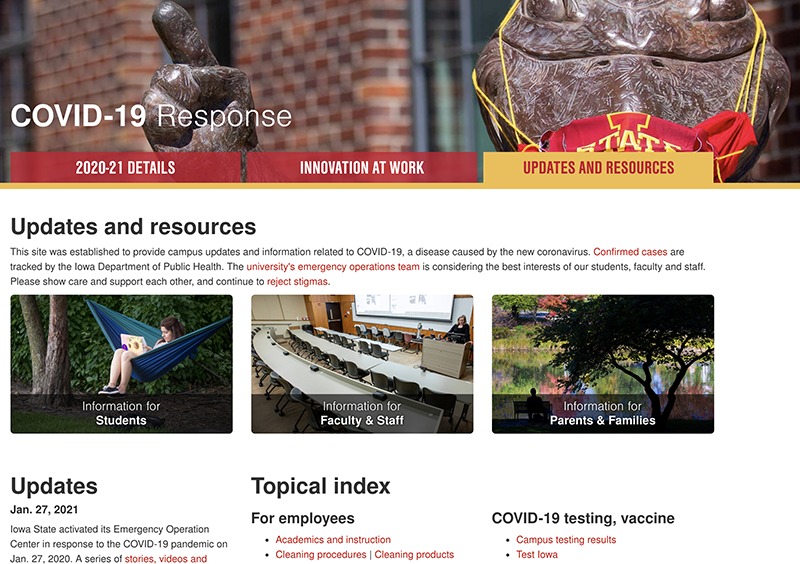
The COVID-19 response website is the university's central spot for news and information related to the virus.
Have a question about how Iowa State is responding to an issue related to the coronavirus? There shouldn't be any question about where to look for answers.
What started out about a year ago as a placeholder website for possible COVID-19 news has become the university's central information source during the pandemic. The COVID-19 response website is where Iowa State shares the latest updates about the virus, addresses common questions and catalogs relevant resources -- a home for crucial campuswide communication and a launchpad for digging deeper into specifics.
The website is constantly evolving as new material is added and out-of-date or less relevant information is removed or reworked, said communications specialist Erin Rosacker, who curates the site along with others in strategic relations and communications and the president's office.
"It’s been a fluid situation, so we’ve had to be nimble to keep everything manageable and not bog it down," Rosacker said. "I’m also making sure things are added that need to be added. You shouldn’t have to search through 700 emails to find what you want to know."
The 2020-21 details section of the website outlines important information about academics, student life, health and safety, and other logistics -- the foundations of the COVID-19 response. The innovation at work section is a collection of ISU news stories related to the coronavirus. The updates and resources section hosts an archive of COVID-19 memos from senior leaders, a topic-based index of links, and FAQs for students, employees and families.
Finding the COVID-19 response website is easy, as there are prominent links to it on the main university homepage. Unit websites that maintain a page with COVID-19 resources should be sure to include a link to the central site, as well. Email Rosacker at edavison@iastate.edu with any suggested additions or comments about the website.
"There’s a lot of collaboration across campus to make that site as helpful as possible," she said. "I think it's doing its job as an overall information resource. You'd hope that people would make a habit of checking it."
New gaming room brings students together, promotes camaraderie
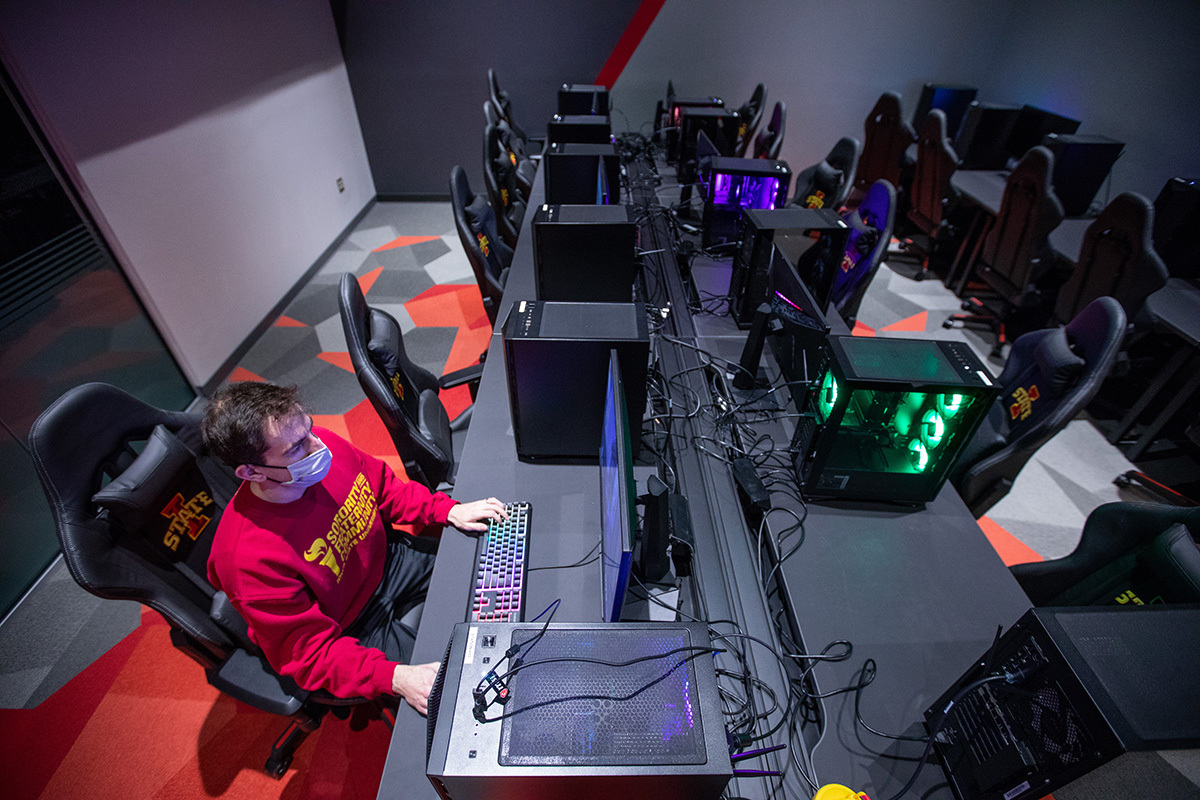
Recreation services associate director of student success Jason Vlastaras uses a gaming station inside the gaming and esports room in Beyer Hall. The space opened Feb. 1. Photos by Christopher Gannon.
A major reason recreation services wanted to turn a pair of Beyer Hall squash courts into a gaming and esports room was the opportunity for more student interaction.
Gaming
The gaming and esports room in Beyer Hall is available from noon to 10 p.m., except Saturday when the building closes at 6 p.m. Faculty and staff with a recreation services membership can use the room.
Instead of sitting in their dorm rooms, gamers now have a space to gather, socialize, practice and compete. The room officially opened Feb. 1, but the Gaming and Esports Club tested out the computers and system last week.
"We had a soft opening and were able to work out a lot of the kinks," rec services associate director for student success Jason Vlastaras said. "To build relationships and have peer-to-peer interaction was the main purpose of this space before COVID, and it has just been highlighted during COVID.
"Our first day of piloting, there was a group of students talking and it seemed like they knew each other. Partway through, one of them asked, 'Hey, what is your Discord name?' Discord is a chat server and you realize these are students who have interacted for a long time, but this is the first time they are meeting in person."
The process
The conversion began in fall 2019 and concluded this January, with COVID-19 delaying the project about one semester.
A pair of club members -- Ryan Helfers and Mitchell Garrett, who have since graduated -- played a significant role in designing the space for their industrial design senior capstone project.
"They did some 3D designs we could show to facilities planning and management and did a virtual reality walkthrough," Vlastaras said.
The room is divided into two areas: a competitive room with 13 desktop computers for the Gaming and Esports Club to reserve and an open space with 20 desktops students can reserve for up to three hours. There also are four consoles for drop-in use so students can hang out and play PlayStation 4, Xbox One and Nintendo Switch.
The club currently hosts competition in 10 games, with multiple teams and skill levels within each game. The new room likely will host intramural tournaments, and the club has larger tournaments that bring in teams from across the country.
Vlastaras also is working with a research group on campus to add a couple of computers that feature games designed on campus.
"They will do some research around gamification and the benefits of that," said Vlastaras of adding game elements to tasks to encourage people to do them.
Needed area
Before dedicating space to gaming and esports, Vlastaras met with leaders of the gaming club and learned competitive gamers had few places to meet and practice. That meant many gamers didn't know one another. When the club gathered for social events, interested students were limited by not having the correct hardware.
"We moved them into a sport club designation which gives them better access and resources under recreation services, so they are a student club but also a sport club," Vlastaras said.
Vlastaras sent a survey to campus and learned that three-fourths of students game in some manner and most play games for a significant amount of time.
Safety
The room's capacity is 37 people but with coronavirus precautions where every other station is used, current capacity is 18. Cyclones Care behaviors also are followed.
"We have a partnership with the College of Liberal Arts and Sciences. They donated money for us to purchase the majority of the PCs for the space," Vlastaras said. "By chance they also oversee the testing labs on campus, so we have learned how they operate those."
Vlastaras said the reservation system for the esports room uses the same appointment software as the testing centers. Rec services hired student staff to manage and clean the space, and everyone who enters the room is given a disinfectant wipe to clean their stations.
"We also have a giant disinfecting cabinet that sanitizes equipment," Vlastaras said. "It runs through keyboards and mice every couple of hours."
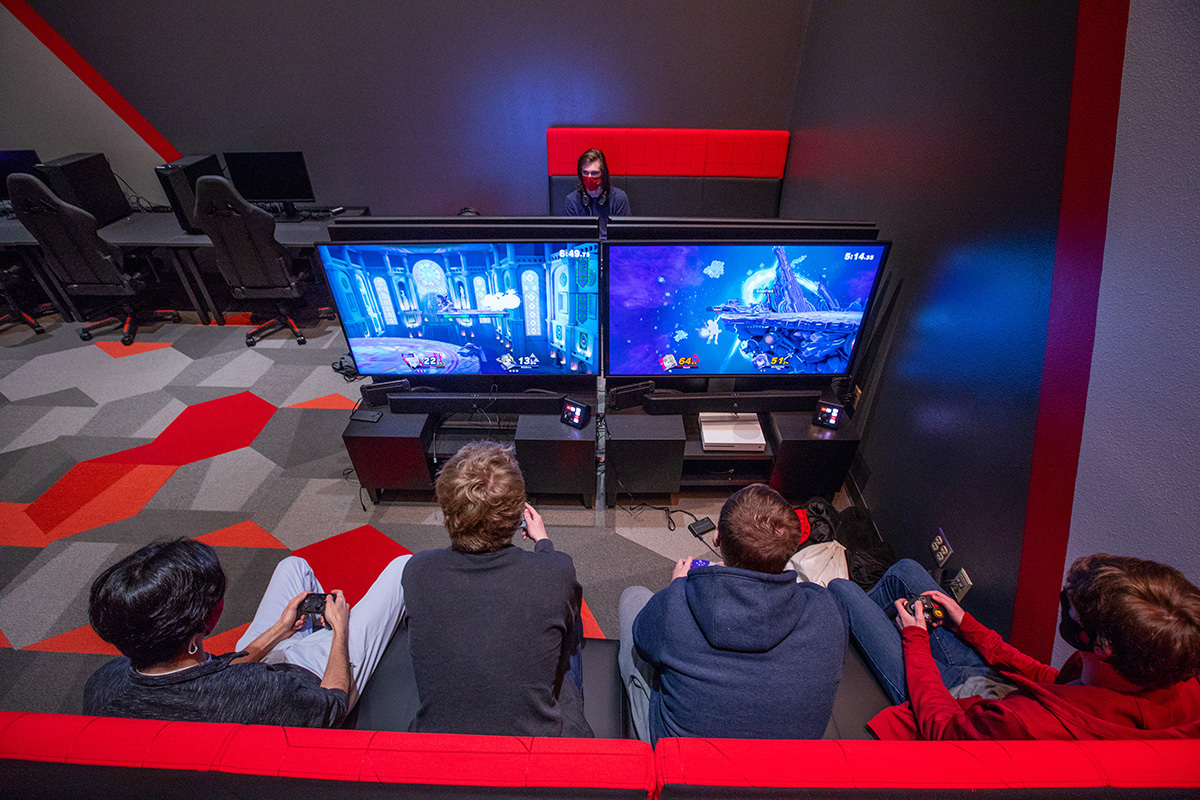
Students use gaming stations inside the gaming and esports room in Beyer Hall on Tuesday. The room was designed by former students on two former squash courts.
Application deadline approaches for retirement incentive program
With less than four weeks remaining in a seven-month application window, 247 employees are approved to participate in the university's 2020-21 retirement incentive option (RIO). Another 36 applications are pending and 19 applications were either withdrawn, denied or ineligible, according to Bonnie Whalen, associate vice president for institutional financial strategy.
Learn more
The university isn't planning to offer another retirement program this year or change the incentives in the current one, she said.
Approved in July by the state Board of Regents, Iowa State's RIO is one piece of a broader university plan to address a $41 million budget deficit this fiscal year due to a smaller student body, flat tuition rates and less state operating support.
Eligible employees may apply to the program through March 1, and approved participants need to retire from Iowa State by June 30. A link to the RIO interest form is available on the program website. Whalen said the current participation level will save the university an estimated $9.5 million in the fiscal year that begins July 1.
Who's eligible?
The RIO is open to benefits-eligible employees who meet a rule of 70 (age and continuous length of university service) and are at least 60 years old on their retirement date. Employees are not eligible if they were accepted previously for another ISU retirement program, such as phased retirement. Participants choose from three incentives:
- Two years of monthly employer's retirement contributions, plus health and dental coverage* (employer and employee costs) up to the self and spouse/partner level
- Three years of retirement contributions
- Three years of health and dental coverage*
*Requires five years of continuous participation in ISU medical/dental plans prior to retirement
When it was announced last summer, university leaders noted that eligibility doesn't guarantee approval to participate in the program. Division leaders, who make the final decisions, must look for cost savings as they review requests.
Where to get answers
|
For questions about: |
Contact: |
|
Your participation in the RIO |
Your manager |
|
Health and dental Insurance in retirement |
Benefits office: 515-294-4800 or benefits@iastate.edu |
|
Retirement plan limitations, impacts to payroll and associated deductions and taxes |
Payroll, benefits and tax: 515-294-7662 or fbac@iastate.edu |
|
Retirement planning and investment options (for TIAA participants) |
Ames TIAA office: 800-732-8353 |
|
Retirement planning and investment options (for IPERS participants) |
IPERS: 800-622-3849 or www.IPERS.org |
Preparing for retirement
Benefits director Ed Holland encourages employees participating in the RIO -- and those who still are thinking about applying -- to contact the benefits office, 294-4800, to discuss their benefit options in retirement.
In addition, university human resources is offering its Ready, Set Retire! workshop Feb. 4-5 via Zoom. Designed for employees who are nearing retirement, it features presentations by ISU benefits professionals and subject-matter experts from several retirement-related programs. Employees -- and their spouses -- may join the sessions that are relevant to their situation.
- Thursday, Feb. 4 (2 sessions): Medicare, Social Security and resources from SHIIP (the state's Senior Health Insurance Information Program); ISU medical/dental insurance for retirees and voluntary retirement savings
- Friday, Feb. 5 (3 sessions): IPERS, TIAA retirement income options and emotional aspects of retirement (with Employee and Family Resources)
Related stories
- Retirement incentive plan clears regents, July 30, 2020
- Retirement incentive proposal goes to regents next week, July 23, 2020
